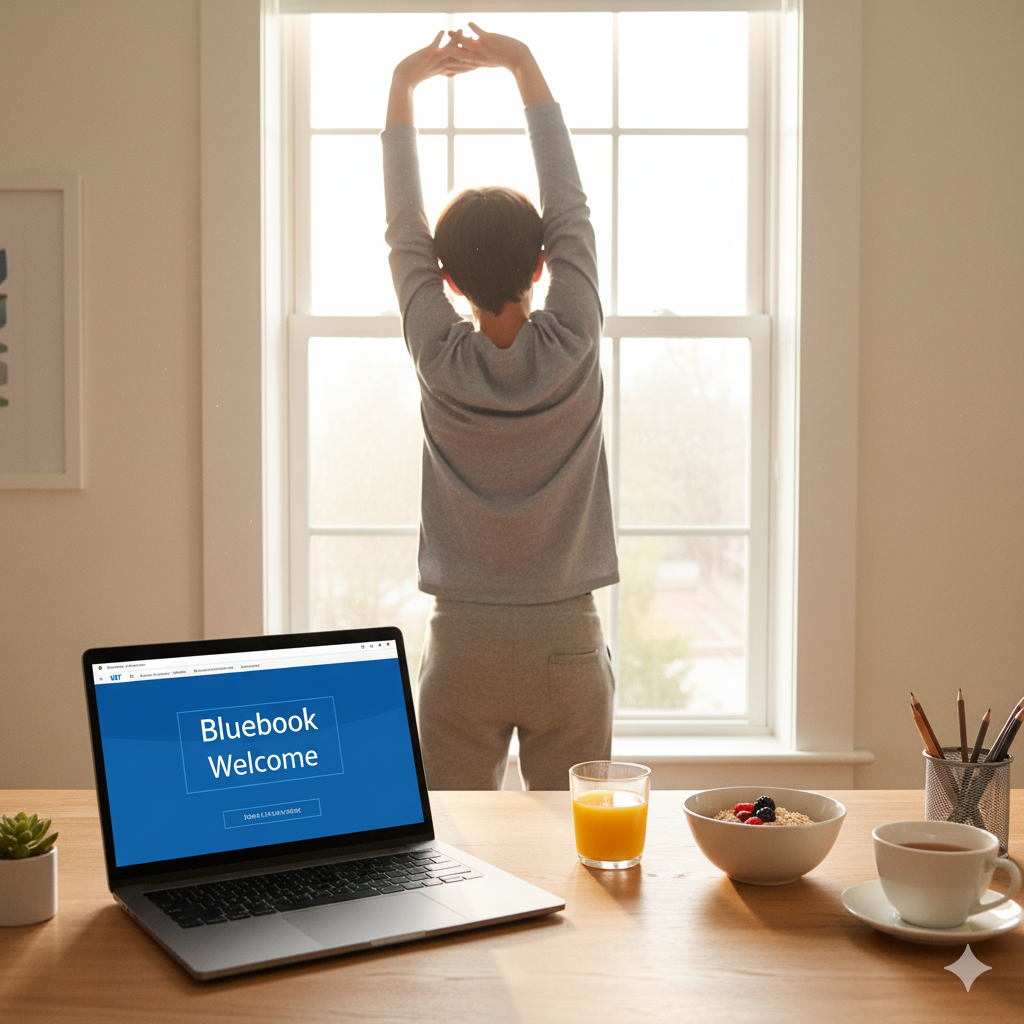Why Test-Day Nerves Are Totally Normal (and Why That’s Okay)
Close your eyes for a second and picture the morning of the SAT: alarm, the commute, the hush of the testing room, the bright screen of the Bluebook app. Your heart speeds up; your palms feel a little clammy. If that sounds familiar, take a breath—literally and figuratively. Test-day nerves are a human signal. They tell your brain that something important is happening. That physiological response—faster heart rate, sharpened senses—can be redirected into useful energy instead of fear.
The goal isn’t to eliminate nerves completely (that’s unrealistic), but to manage them so they help rather than hinder. Below, you’ll find practical strategies that blend preparation, mindset, physical care, and small rituals you can use the night before and the morning of the Digital SAT to feel calmer and more focused.
Before Test Day: Build Confidence So Nerves Have Less Power
Anxiety shrinks when preparation grows. If you do certain things intentionally in the weeks before test day, the moment itself becomes less charged because your brain already knows you’ve prepared.
1. Practice in the exact format
One of the best ways to minimize surprises is to practice using the Bluebook testing environment and the digital tools (including the built-in Desmos calculator). Do at least two full-length practice tests in the same environment you’ll use on test day. That familiarity reduces novelty—novelty increases anxiety.
2. Routine-based study beats last-minute cramming
Short, regular study sessions create steady progress and give your brain time to consolidate learning. Use a study plan that alternates practice tests with targeted review sessions (e.g., reading comprehension techniques one day, formula review another).
3. Learn quick calming techniques ahead of time
Practicing breathing exercises, brief mindfulness breaks, or a three-minute grounding routine in advance trains your body to respond to them when you actually need them.
4. Simulate pressure, then process it
Take at least one practice test under timed, slightly stressful conditions—maybe with a morning wake-up time and minimal notes afterward. Afterwards, journal what worked and what didn’t. Learning how you respond under pressure gives you a playbook for test day.
Night Before: Small Choices That Make a Big Difference
The evening before the SAT shouldn’t be an anxiety marathon. Your choices here set up the next morning.
Checklist for the Night Before
- Charge your testing device and plug in the charger.
- Lay out clothes that are comfortable and appropriate for a cool testing room.
- Pack permitted snacks, water, ID, and your admission ticket printed or saved where you can access it.
- Run a short readiness check on Bluebook if possible (or confirm your school’s readiness check time).
- Do a light review—no heavy learning. Focus on confidence-building: quick math formulas, a short reading passage, or a concise grammar list.
- Practice a calming routine (7–10 minutes): 4-4-8 breathing, progressive muscle relaxation, or a short guided meditation.
- Go to bed at a reasonable hour. Sleep helps consolidate memories and control emotion.
Morning of the SAT: Routines to Keep You Centered
Test-day routines help your brain stop asking “What if?” and focus on “What now?” Here are simple, doable steps that many students find stabilizing.
Wake-up and movement
Get up early enough that you don’t rush. Start with a gentle movement routine—five to ten minutes of stretching or a short walk to reduce cortisol and prime focus.
Breakfast and hydration
Choose a balanced breakfast: complex carbohydrates (oatmeal, whole-grain toast), protein (eggs, yogurt, peanut butter), and some healthy fat. Avoid excessive sugar that can cause energy crashes. Hydrate, but not so much that you’ll need a restroom break in the middle of a section.
Mini mental warm-up
Spend 10–15 minutes doing a low-stakes practice activity: one reading passage, a handful of easy math questions, or a few grammar items. This wakes up your test muscles without creating pressure.
Use a short grounding routine right before you enter the test room
A three-breath reset, or the simple 5-4-3-2-1 grounding technique (name 5 things you can see, 4 you can touch, 3 you can hear, 2 you can smell, 1 you can taste), can redirect nervous energy into the present moment.
During the Test: Real-Time Strategies to Manage Anxiety
When the clock starts, nerves can spike. Here are concrete habits to use in the testing room that keep worry from taking over.
1. Start with a quick set-up ritual
Before you begin answering, take a moment to settle: adjust your seating, take three slow breaths, and read the first instruction carefully. A short ritual helps your brain switch into “task mode.”
2. Break the test into bite-sized tasks
Instead of seeing three hours of testing, frame it as: “First section, 10 questions; Second section, one passage; treat each question as a micro-task.” This reduces cognitive load.
3. Use time management anchors
Set informal checkpoints (e.g., “By the 20-minute mark I’ll be halfway through this section”) rather than watching the clock constantly. These anchors are gentle guides—not hard deadlines—and prevent panic that comes from perceived falling behind.
4. When you feel stuck: use triage
Have a simple decision rule: if a question is taking longer than your predetermined limit, mark it, make an educated guess if needed, and move on. Return to marked items during review time. This preserves momentum and prevents one question from derailing you.
5. Micro-reset (30–60 seconds)
When anxiety spikes: stop, close your eyes (if possible), inhale for a count of four, hold for four, exhale for six. Do two cycles. This slows heart rate and clarifies thinking faster than willpower alone.
6. Keep your body comfortable
Adjust posture, roll shoulders, and sip water in the breaks. Physical ease supports cognitive clarity.
Mindset: Talk to Yourself Like a Coach, Not a Critic
Our internal dialogue shapes our emotional response. A small change in wording can shift your physiology and focus.
Examples of helpful self-talk
- Instead of “I’m going to mess up,” try: “I’ve practiced this—one question at a time.”
- Instead of “I should know this,” try: “I’ll do my best with the information I have.”
- Instead of “I’m panicking,” try: “I’m noticing signs of nervousness; I can use a breathing reset.”
Short, factual statements (“I have 20 minutes for this section, one question at a time”) are especially effective because they engage the problem-solving parts of your brain and quiet the alarm center.
Practical Table: Quick Toolbox for Test-Day Nerves
| When | What to Do | Why It Helps |
|---|---|---|
| Night before | Lay out materials, charge device, light review, 7–10 min breathing | Reduces morning scramble and calms the nervous system |
| Morning | Balanced breakfast, short walk, mini practice, 3-breath ritual | Steadies energy and primes cognitive function |
| First 5 minutes of test | Set up ritual: adjust, breathe, skim instructions | Creates focus and reduces reactionary stress |
| When stuck | Use triage: mark, guess, move on; return later | Preserves time and momentum |
| Mid-test | Micro-reset: 2 slow breath cycles; roll shoulders | Brings down heart rate and restores clarity |
What to Do If Anxiety Escalates Mid-Test
Sometimes nerves don’t stay small. If you find yourself experiencing a significant anxiety spike—racing thoughts, dizzy sensation, nausea—use a stepped approach.
Step 1: Pause and breathe
Stop typing, put your hands on your lap for a moment, and do 5 rounds of paced breathing (inhale 4, exhale 6). Slower exhalation activates the parasympathetic system—your natural calming circuit.
Step 2: Grounding
Quickly do the 5-4-3-2-1 sensory exercise (name things you see, touch, hear, smell, taste). This moves attention away from fear loops and back to present sensory data.
Step 3: Reassess the plan
Remind yourself of the test strategy: triage tough questions, pick low-hanging fruit, and maintain steady pacing.
Step 4: Ask for help if needed
If your anxiety becomes overwhelming and you feel it will prevent you from continuing, raise your hand and explain to a proctor. In many cases, a short break, repositioning, or simply speaking to staff can reset the situation. If you have documented accommodations, ensure you follow the guidelines for accessing them.
After the Test: Process, Don’t Obsess
Once the test is over, it’s tempting to replay every question. That’s normal but not helpful. Give yourself a structured decompression—then move on.
Post-test routine
- Take 20–30 minutes to decompress: walk, have a snack, breathe.
- Don’t analyze performance immediately. Wait until you have practice-test data to compare with. One test isn’t the full story.
- Reflect constructively: What felt good? What could you tweak for next time?
How Personalized Support Can Reduce Test-Day Anxiety
Sometimes the best way to calm nerves is to remove uncertainty. Personalized tutoring gives you a tailored plan to close knowledge gaps, develop test strategies, and practice under simulated conditions. Services like Sparkl’s personalized tutoring offer 1-on-1 guidance, tailored study plans, expert tutors, and AI-driven insights that can identify weak spots faster than guesswork. Knowing you have a plan built around your strengths and weaknesses turns fear into manageable steps.
Even a few targeted sessions—working through pacing strategies, practicing with Bluebook, and rehearsing test-day rituals—can dramatically reduce the emotional charge you feel on test day. Personalized tutors can also role-play stressful moments (timed sections, mid-test anxiety spikes) and help you rehearse responses so the real moment feels familiar.
Real-World Examples: Small Adjustments, Big Impact
Here are a few short stories that illustrate how tiny changes can shift outcomes.
Case A: The over-caffeinated morning
Samantha swore by her morning coffee. On practice days she noticed jitters and shaky hands. She switched to a half-cup and added a protein-rich breakfast. The difference: steadier focus and better stamina for later sections.
Case B: The “one question” trap
Jason would spend too long on one tricky math problem and then panic. He adopted a simple triage rule: if a question takes longer than twice your average target time, mark and move on. His overall score improved because he completed more questions confidently.
Case C: The power of simulation
Aisha took three full-length digital practice tests in Bluebook with timed breaks and a morning wake-up time. She arrived on test day and felt oddly calm—she had already lived the scenario. That reduced her anxiety and allowed her to perform at her practiced level.
Final Thoughts: Nerves Don’t Have to Dictate the Outcome
Test-day nerves are part of the equation, but they aren’t the final word. With the right preparation—format practice, consistent routines, simple calming techniques, and occasionally a little outside help like personalized tutoring—you can significantly reduce the emotional drag on your performance. Think in terms of habits and rehearsals: the body remembers routines, and the brain learns calm through practice.
Walk into the test with a short ritual, a few reliable tools in your pocket, and the knowledge that even high-performing students feel nervous sometimes. Use those nerves as a nudge toward focus, not a barrier to your best work.
Quick Reference: 10 Actionable Steps to Use Right Now
- Practice at least two full-length tests in Bluebook before test day.
- Download and run the device readiness check at least 30 days before your test.
- Create a sleep schedule the week before and stick to it.
- Plan a balanced breakfast and pack smart snacks.
- Develop a 3–5 minute pre-test ritual (breathing + posture check).
- Use triage for tough questions: mark, guess if needed, move on.
- Do a 30–60 second breathing reset if anxiety spikes.
- Reflect constructively after the test—don’t obsess.
- Consider a short series of personalized tutoring sessions to refine timing and build confidence.
- Trust your preparation and treat the test like another practice session with higher stakes.
Want a Little Extra Help?
If nerves are a recurring roadblock, you don’t have to tackle them alone. Tailored, empathetic tutoring can accelerate progress and create steady confidence. A few sessions focused on pacing, Bluebook familiarity, and simulated test-day rehearsals—paired with an individualized study plan and actionable feedback—often shifts performance more than a month of unfocused practice.
Parting Note
The SAT matters, but it’s not a measure of your worth. It’s a snapshot of skills on a particular day. By building routines, practicing the format, and preparing both your mind and body, you give yourself the best chance to perform as you’ve prepared. When nerves appear, greet them as a normal signal—and use the tools above to turn that signal into steady, useful energy.
Take a deep breath. You’ve prepared. You’re ready.














No Comments
Leave a comment Cancel